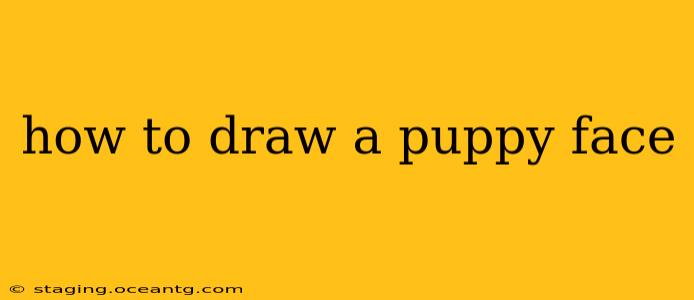How to Draw an Adorable Puppy Face: A Step-by-Step Guide
Drawing a puppy face can be a fun and rewarding experience, regardless of your skill level. This guide will walk you through the process, from basic shapes to adding those charming details that bring your puppy to life. We'll cover different styles, so you can find the approach that best suits your artistic preferences.
Step 1: The Basic Shapes – Laying the Foundation
Before diving into intricate details, start with simple shapes to establish the puppy's overall structure. A circle for the head is a great starting point. Then, add smaller circles or ovals for the puppy's eyes, nose, and ears. These shapes don't have to be perfect; slightly uneven forms can add to the puppy's charm and realism. Consider the breed you're aiming for – a long-snouted dachshund will have different proportions than a fluffy Pomeranian.
Step 2: Defining the Eyes – The Windows to the Soul
Puppy eyes are incredibly expressive! Draw two slightly oval shapes for the eyes, ensuring they're spaced appropriately within the head. Add smaller circles inside for the pupils, leaving some white space for highlights that will make them sparkle. Consider adding little tear ducts in the inner corners for extra cuteness. Experiment with the eye shape to convey different emotions – wide eyes for alertness, slightly closed eyes for sleepiness.
Step 3: The Nose – The Centerpiece
The nose is another key feature. For most puppies, a small, triangular or heart-shaped nose works well. Place it centrally below the eyes. Add a little shading to give it dimension and depth.
Step 4: Adding the Ears – Floppy or Prickly?
Puppy ears vary greatly depending on the breed. Floppy ears can be drawn as soft, rounded shapes hanging down from the sides of the head. Prickly ears are pointier and stand erect. Pay attention to the way the ears fold and curve to capture their unique character.
Step 5: The Mouth – A Smile or a Pant?
A simple curved line can create a sweet, happy mouth. For a more expressive look, add a slightly open mouth with a little tongue sticking out. This adds a playful touch to your puppy drawing.
Step 6: Adding Fur and Details – Bringing it All Together
Once the basic features are in place, it's time to add details. Soft, rounded lines can suggest fur. You can add shading to create depth and texture – darker areas in the fur can add realism. Consider adding tiny whiskers around the nose and mouth.
Step 7: Experiment with Different Styles
Don't be afraid to experiment! You can create a cartoonish puppy with simplified shapes and bold lines, or a more realistic puppy with detailed shading and fur textures. The possibilities are endless!
Frequently Asked Questions (PAAs)
What materials do I need to draw a puppy face?
You'll need a pencil, eraser, and paper to start. Colored pencils, markers, or paints can be used to add color and detail later.
How do I make my puppy drawing look realistic?
Focus on accurate proportions, add subtle shading to create depth, and pay close attention to the details like fur texture and eye shine. Observe real puppies to understand their features and expressions.
Can I draw a puppy face from a photo?
Absolutely! Using a photo as a reference can help you to accurately capture the proportions and details of the puppy's face.
What are some tips for beginners?
Start with simple shapes, don't be afraid to make mistakes (it's part of the learning process!), and practice regularly. The more you draw, the better you'll get.
What if my puppy drawing doesn't look perfect?
That's okay! Drawing is a journey, not a race. Focus on the process of learning and having fun. Don't be discouraged if your first attempts aren't perfect – keep practicing, and you'll see improvement over time.
By following these steps and experimenting with different techniques, you'll be well on your way to creating adorable puppy drawings that capture the charm and personality of these beloved animals. Remember, practice makes perfect, so have fun and keep creating!
